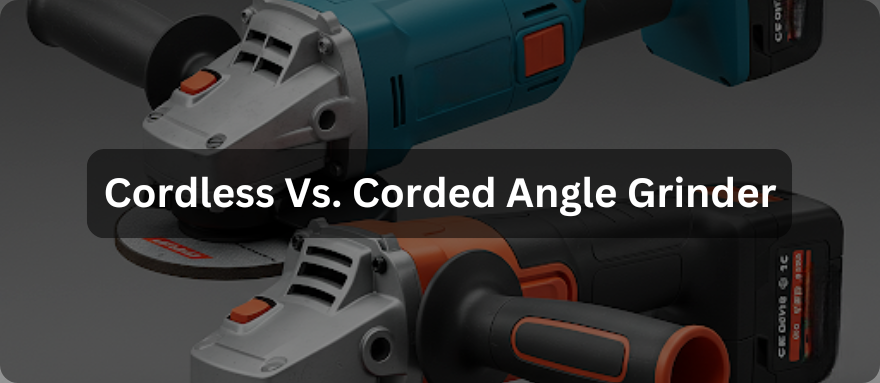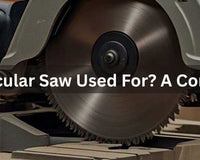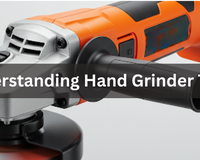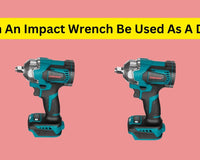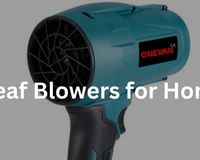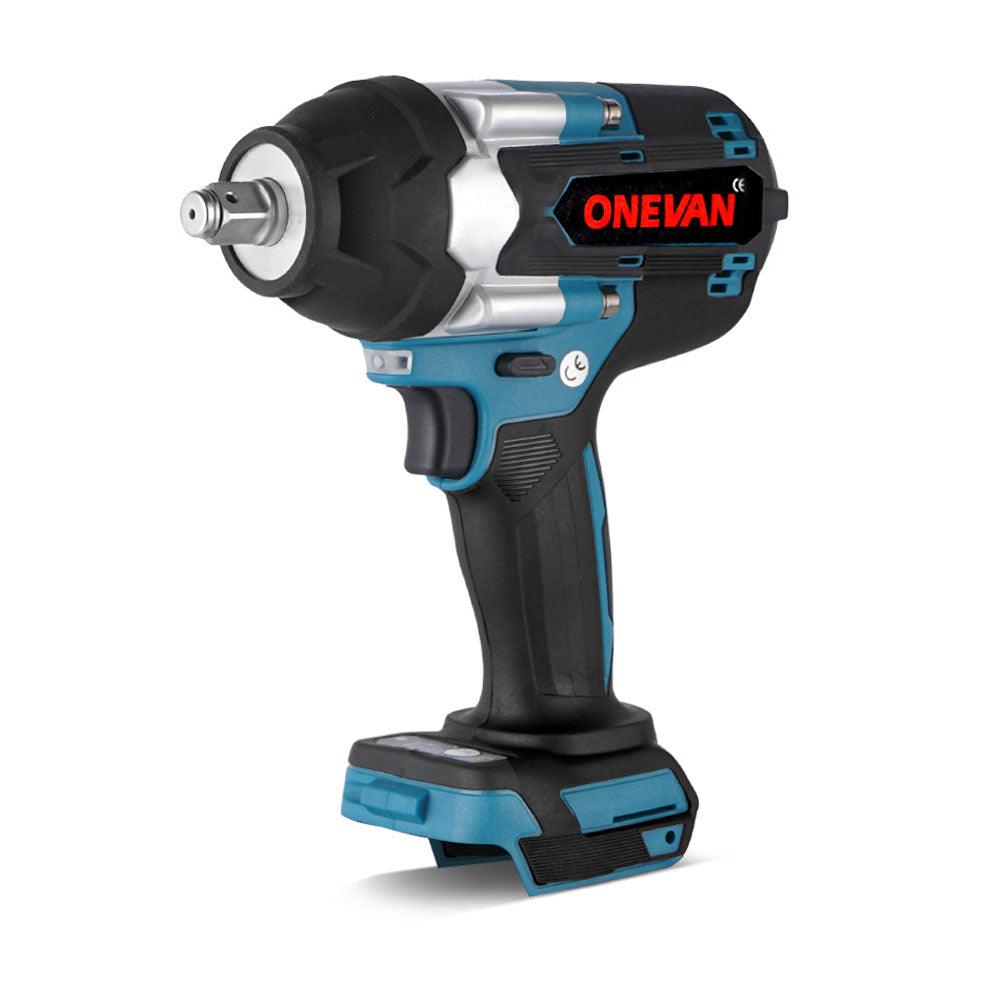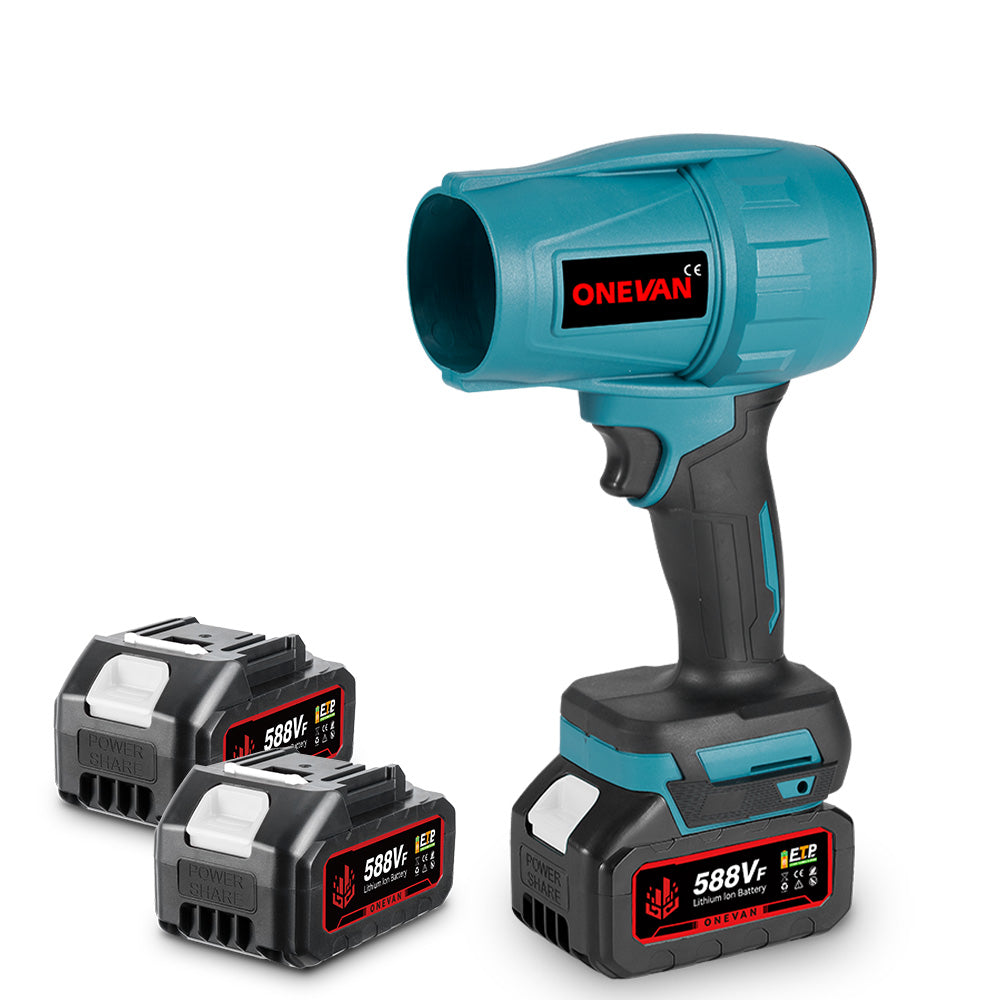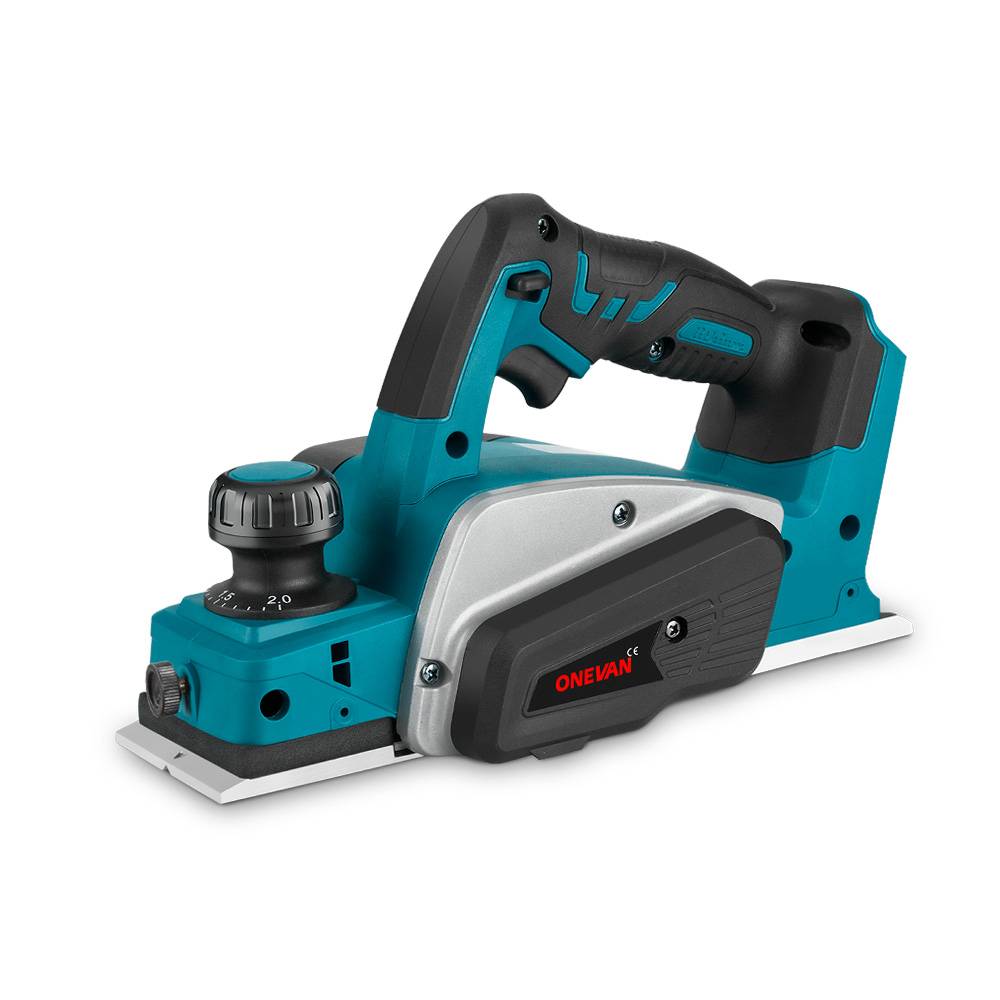How do you choose a corded and cordless angle grinder? Your decision can significantly impact your performance on a workshop or job site. These powerful tools are essential for cutting, grinding, and polishing various materials, including metal. For example, you've probably stood in the hardware store, looking at both options but confused about which one is the better choice for your needs. While both types can get the job done, each comes with some impeccable advantages that could fulfill your project needs. Let's cut through the noise and determine which belongs in your toolbox.
1. Understanding Angle Grinders
Angle grinders consist of various components, and understanding them is essential for practical use.
What is an Angle Grinder?
An angle grinder is a handheld power tool designed to cut, grind, and polish various materials. It features a motor that powers a rotating head that can be fitted with different discs/attachments. The head is positioned at a specific angle relative to the motor housing, allowing you to work comfortably on flat surfaces while maintaining optimal control and visibility of the work area.
Key Features of Angle Grinders
Speed (RPM)
A very key feature of an angle grinder is its RPM. Angle grinders operate between 6,000 to 12,000 RPM. Higher speeds provide more aggressive cutting power and are ideal for rigid materials. Conversely, lower speeds allow for better control in tasks that require precision and polishing.
Disc Size
Available disc sizes range from 3 to 9 inches, with 4½ and 5 inches being the most commonly used. Smaller discs provide better control and precision for detailed work. Larger discs cover more surface area and are better suited for heavy-duty cutting and grinding tasks.
Power Ratings
Corded models range from 500W to 2500W. Cordless models use battery systems rated from 18V to 36V. Higher power ratings translate to better performance on demanding materials but increase the tool's weight and cost.
Safety Features
Modern angle grinders include soft start mechanisms to prevent initial torque reactions, anti-kickback protection to stop the tool if the disc binds, and emergency braking systems for immediate disc stoppage when needed. Many models also feature adjustable guards and ergonomic handles with vibration reduction.
Different Types of Angle Grinder Wheels
Cutting Discs
Thin, reinforced discs specifically designed for making straight cuts through metal, including pipes, rebar, and sheet metal.
Grinding Wheels
Thicker abrasive discs are made for material removal, beveling edges, and surface preparation. These wheels effectively smooth rough surfaces and remove excess material.
Wire Brush Wheels
Circular arrangements of steel or brass wire bristles are used to remove rust, paint, and scale. These wheels effectively clean surfaces and prepare them for painting or coating.
Diamond Wheels
Premium wheels embedded with industrial diamonds, specifically designed for cutting and grinding hard materials like concrete, tile, stone, and masonry.
Flap Discs
Layered arrangements of abrasive material, providing consistent surface finishing and material removal. Available in various grits for different finishing requirements.
Polishing Pads
Specialized attachments made from foam or wool are used with polishing compounds to achieve high-gloss finishes on metal and stone surfaces.
Typical Applications for Angle Grinders
Metalworking Applications
For cutting metal stock, position the grinder at a 15 to 20-degree angle, allowing the weight of the tool to assist in the cutting process. Start with a shallow guide cut, then gradually increase depth. When smoothing welds, use broad sweeping motions with a flap disc while keeping the disc parallel to the weld line. For deburring edges, hold the grinder at approximately 45 degrees, moving steadily along the edge while applying light pressure to avoid gouging.
Construction and Masonry Work
When cutting tiles, score the surface first with light pressure, then make increasingly deeper passes until the tile is cut through. For concrete cutting, apply water to the cutting area to reduce dust and prevent disc overheating. Mark your cutting line clearly and start with a shallow groove for guidance. Remove old mortar by holding the grinder parallel to the surface, working in horizontal passes across the joints. Keep the disc flat to avoid damaging surrounding bricks.
Woodworking Projects
For wood shaping, use a coarse flap disc and consistently work in the direction of the grain. Make multiple light passes rather than forcing the tool. Start with 40-grit for aggressive material removal, then progress to finer grits for smoothing. When removing paint, keep the grinder in motion to prevent burning the wood underneath. Use wire cups to clean wood in tight corners and detailed areas.
Restoration Work
For stubborn rust, switch to a grinding disc, but watch your pressure to avoid damaging the base metal. When stripping paint, use cup wheels for flat surfaces and corner wheels for detailed areas. Always work from clean areas into corroded areas to prevent spreading contamination.
Automotive Repairs
For body panel work, start with a cutting wheel to remove damaged sections, ensuring to cut just outside your marked area for precise final trimming. When modifying exhaust systems, use a thin cutting disc and make your initial cut slightly long, then fine-tune the fit. To remove undercoating or sound deadener, use a wire wheel with the grinder at a low angle to prevent clogging. During rust repair, gradually transition through progressively finer grits to achieve a surface that is ready for primer.
2. Corded Angle Grinders
Advantages of Corded Angle Grinders
Corded grinders deliver consistent power output ranging from 500W to 2500W, maintaining maximum RPM even under heavy loads. The direct power connection allows for sustained high-intensity work without power fluctuations. Most corded models offer higher RPM ranges (up to 12,000) compared to cordless versions, making them more effective for demanding tasks like concrete cutting and heavy metal grinding.
Disadvantages of Corded Angle Grinders
The power cord limits the working range to about 50 feet from power sources, even with extension cords. Cords can become entanglement hazards in crowded workspaces and present trip risks. Cord management also makes working on elevated platforms or scaffolding more challenging. Power fluctuations in remote locations can affect performance and potentially damage the tool.
Ideal Applications for Corded Angle Grinders
Workshop-based metalwork requires consistent power output for extended grinding sessions and heavy material removal. Production environments benefit from the unlimited runtime for batch-processing tasks. Construction tasks like concrete cutting and mortar removal need sustained high power. Fabrication work involving thick materials demands the higher amperage that corded models provide.
3. Cordless Angle Grinders
Advantages of Cordless Angle Grinders
Complete mobility allows work in remote locations and elevated positions without cord management. Quick setup and pack-up increase efficiency for short tasks. Eliminating cord-related safety hazards improves workplace safety. Many modern cordless models can achieve speeds up to 9,000 RPM, which is sufficient for most common applications.
Disadvantages of Cordless Angle Grinders
Battery runtime limits heavy work sessions to 20-30 minutes per charge. Power output decreases as battery charge depletes, affecting cutting and grinding efficiency. Additional batteries and chargers increase the initial cost. Total weight increases with higher capacity batteries, causing more user fatigue.
Battery Technology in Cordless Angle Grinders
Lithium-ion batteries offer consistent power output until nearly depleted, with minimal memory effect and longer lifespan. 18V systems provide a good balance of power and weight, while 36V systems match corded power but add weight. Brushless motors extend runtime by 50% compared to brushed motors. Fast-charging technology reduces downtime, with some batteries reaching 80% charge in 30 minutes.
Ideal Applications for Cordless Angle Grinders
Mobile repair work benefits from quick deployment without power source concerns. Outdoor projects and remote site work where power access is limited. Emergency repairs in confined spaces where cord management would be difficult. Light to medium-duty tasks requiring frequent position changes.
User Experience with Cordless Angle Grinders
Professional contractors report that cordless angle grinders perform excellently in quick-cutting tasks and surface preparation. Construction workers praise the grinders, which provide the convenience of overhead work and tight spaces. Maintenance technicians note that cordless angle grinders can improve efficiency in remote repairs. Users consistently mention the importance of having multiple batteries for extended work sessions when using a cordless angle grinder. Weight distribution and ergonomics receive positive feedback, particularly in newer models with rubberized grips and adjustable handles.
The ONEVAN cordless angle grinder lineup offers two distinct models tailored to different user needs and project requirements. Choosing the appropriate tool is crucial for maximizing efficiency and ensuring safety.
ONEVAN 125mm Brushless Cordless Angle Grinder
The ONEVAN 125mm Brushless Cordless Angle Grinder is designed for demanding applications requiring significant power and material removal capacity. Its larger 125mm (5-inch) disc diameter facilitates deeper cuts and faster grinding, making it suitable for professional tradespeople and serious DIY enthusiasts tackling substantial projects. This model excels in construction settings for cutting concrete, masonry, and tile; in metalworking for cutting and shaping thicker metal stock; and in automotive applications for rust removal and bodywork. Its robust design and powerful motor make it the tool of choice when tackling heavy-duty tasks.
ONEVAN 76mm Brushless Cordless Angle Grinder
Conversely, the ONEVAN 76mm Brushless Cordless Angle Grinder prioritizes portability, maneuverability, and precision. Its smaller 76mm (3-inch) disc makes it ideal for intricate work, close-quarters applications, and projects where portability is paramount. This model is particularly well-suited for DIY enthusiasts, hobbyists, and light-duty users. It excels at tasks such as tile cutting for backsplashes, grout removal, light grinding and polishing, and smaller-scale rust removal. Its compact size and lighter weight make it comfortable to use for extended periods and easy to store. The 76mm grinder is the optimal choice when precision and ease of handling are more critical than raw power.
4. Cordless vs Corded Angle Grinders: A Comparison
Mechanism of Action
Corded angle grinders operate through direct AC power conversion, delivering consistent electrical current to the motor. The motor directly powers the spindle through a gear reduction system, maintaining constant torque under load.
Cordless angle grinders use DC power from batteries, converting it through a controller system. Brushless motors use electronic commutation for power delivery, while brushed motors use physical contacts. The voltage remains consistent until battery depletion, where power output gradually decreases.
Performance and Efficiency
Corded angle grinders consistently deliver 500W-2500W power output, maintaining maximum speed under load. They achieve higher maximum speeds (12,000 RPM) and sustain performance during extended use.
Cordless units operate at 18V-36V, providing 800W-1500W equivalent power. Maximum speeds reach 9,000 RPM, with performance declining as battery charge decreases. Material capabilities vary with battery charge level.
Weight and Design
Corded models typically weigh 4-6 pounds, with weight concentrated near the motor. Their design focuses on durability and heat dissipation, with cord strain relief as a key component.
Cordless units weigh 5-8 pounds with a battery installed. Weight distribution varies with battery placement, affecting balance and user fatigue. Modern designs incorporate battery slide mechanisms and electronic displays.
Cost Considerations
Corded Initial Investment: \$50-200 for professional models Operating Costs: Minimal, primarily electricity consumption Maintenance: Limited to brush replacement and cord care
Cordless Initial Investment: \$150-400 including batteries and charger Operating Costs: Battery replacement every 2-3 years (\$50-100 per battery) Maintenance: Battery care, electronic system maintenance
Noise Levels and Vibration
Corded models generate 85-95 decibels under load. Vibration levels measure 4-8 m/s², and the vibration patterns are consistent throughout the operation.
Cordless units produce 80-90 decibels, with variable vibration levels (3-7 m/s²) depending on battery charge. Electronic speed control helps reduce vibration fluctuation.
Environmental Impact
Corded Impact:
- Lower electronic waste generation
- Higher energy efficiency during operation
- Longer operational lifespan
- No battery disposal concerns
Cordless Impact:
- Battery recycling requirements
- Electronic component disposal needs
- Reduced energy efficiency due to charging losses
- Shorter overall tool lifespan
|
Feature |
Corded Angle Grinders |
Cordless Angle Grinders |
|
Power Output |
500W-2500W continuous |
800W-1500W equivalent |
|
Maximum RPM |
Up to 12,000 |
Up to 9,000 |
|
Working Time |
Unlimited |
20-30 minutes per charge |
|
Weight |
4-6 pounds |
5-8 pounds with battery |
|
Initial Cost |
\$50-200 |
\$150-400 |
|
Maintenance Needs |
Low |
Moderate |
|
Mobility Range |
Limited by cord length |
Unlimited |
|
Power Consistency |
Highly consistent |
Varies with battery charge |
|
Heat Generation |
Higher |
Lower |
|
Life Expectancy |
8-10 years |
5-7 years |
|
Startup Time |
Immediate |
Immediate |
|
Safety Features |
Restart protection |
Electronic cell protection |
|
Operating Cost |
Low |
Moderate to High |
|
Work Environment |
Indoor/powered sites |
Any location |
|
Best Use Case |
Continuous heavy work |
Mobile, intermittent use |
|
Vibration Control |
Mechanical |
Electronic |
|
Storage Requirements |
Minimal |
Needs battery storage |
|
Emergency Use |
Requires power source |
Ready when charged |
|
Weather Resistance |
Limited by electrical safety |
Better weather resistance |
5. How to Choose the Right Angle Grinder for Your Needs
An angle grinder is like a powerful spinning tool that can cut, grind, and polish different materials. Let's learn how to pick the perfect one for your projects!
Assessing Your Projects
When working with metal, you'll want a grinder with at least 7-11 amps of power. This gives you enough strength to cut through steel pipes or grind down welds. Look for grinders with metal gear housings, as they last longer when working with hot metal sparks.
For masonry and concrete projects, choose a grinder with dust protection features. These have special seals that keep tiny dust particles from damaging the motor. A grinder between 4.5 inches and 5 inches is suitable for most concrete jobs.
If you're mainly working with wood, smaller grinders around 4 inches are ideal. They're lighter and easier to control when shaping wood. Make sure to get one with variable speed settings, as wood needs slower speeds to prevent burning.
Professional Vs. DIY Use
For DIYers, cordless angle grinders offer unmatched convenience and portability, allowing for easy movement and use in various locations without the hassle of cords. While corded grinders provide consistent power suitable for heavy-duty, continuous use, the freedom and flexibility of cordless tools make them the preferred choice for most homeowners tackling occasional projects around the house. Modern battery technology has also made cordless grinders increasingly powerful, further solidifying their appeal for DIY tasks.
Professional users typically require heavy-duty grinders with at least nine amps of power for demanding tasks. These tools should be able to work 8+ hours daily without issues. Quick wheel change systems are important to save time on busy job sites. Better dust protection is essential for long work sessions, and stronger warranties of 3+ years provide peace of mind for the investment.
Essential Accessories for Angle Grinders
Every angle grinder needs suitable accessories to work well. For cutting metal, you'll need thin, strong cutting wheels that can slice through materials cleanly. Diamond wheels are essential for tile and concrete work, while grinding discs help smooth metal surfaces effectively.
Safety gear is crucial
You should wear a face shield rather than safety glasses, heavy work gloves to protect your hands, ear protection from the noise, and a dust mask or respirator to protect the lungs against harmful particles.
Other helpful features are attached side handles for better control when used, a carrying case that keeps the product stable to protect your investment, spare wheels for different application tasks, and flap discs for finishing work to a smooth surface.
Budgeting for Your Angle Grinder
Entry-level grinders in the \$30-75 range are perfect for occasional home projects. They offer basic safety features and are suitable for learning how to use grinders. Upgrading to mid-range options (\$75-150) offers improved power and durability, along with enhanced safety features, making them ideal for regular DIY use.
Professional-grade grinders (\$150-300+) offer the most potent motors and best safety features, designed for daily heavy use. To save money, consider buying during holiday sales when tools are often discounted. Combining kits with accessories can provide better value. Refurbished tools from reputable brands usually offer excellent value, and corded tools typically cost less than their cordless counterparts.
6. Conclusion
For most people, a mid-range 4.5-inch grinder around \$100 works perfectly for home projects. It provides enough power for serious work without breaking the bank. Professional users should invest in a high-end 5-inch or larger grinder with at least nine amps, as the extra power and durability are essential for daily use. Those planning only light DIY work can get by with a basic 4-inch grinder under $75, provided it has good safety features and comes from a known brand.
7. FAQs
Is a cordless angle grinder suitable for heavy-duty work?
Yes, cordless grinders can handle challenging tasks effectively. However, you should keep an extra battery with you. They are effective for intermittent heavy-duty tasks, but a corded model might be better for all-day heavy use.
How long does the battery last on a cordless angle grinder?
A 5.0Ah battery typically lasts 20-30 minutes during continuous grinding operations. Heavy cutting will drain it faster, so keep a spare battery handy.
Are there special attachments for both corded and cordless angle grinders?
No, attachments work on both types. The main thing is matching the disc size to your grinder. A 4.5-inch grinder needs 4.5-inch discs, regardless of whether it's corded or cordless.
What safety gear is must to operate an angle grinder?
You need a face shield, not just safety glasses. You also need ear protection and a dust mask. Get thick work gloves, too. Wear long sleeves and avoid loose clothing. Steel-toed boots are smart if you're doing lots of cutting.
How does the performance of a cordless angle grinder compare to a corded model?
Modern cordless grinders have the same power as corded ones. The main difference is run time. Corded grinders can run all day, while cordless ones need battery changes. Because of the battery, cordless tools are often heavier.
What should I consider when maintaining my angle grinder?
Clean the vents after each use. Check the brushes every few months. Keep the cord in good shape (for corded models). Test the safety guard regularly. Replace worn discs right away. Listen for unusual noises - they mean trouble.
How do I know which wattage is suitable for my tasks?
For light home use, 700-900 watts is enough. Medium jobs need 1000-1300 watts. Professional work requires 1400+ watts. Think about what you cut most often. Metal needs more power than wood.
Can I convert a corded grinder to a cordless one?
No, you can't safely convert a corded grinder to cordless. The motors are designed differently. Just buy the type you need. Many brands offer both options at similar prices.
What types of grinding and cutting tasks are best for each type?
Corded grinders are best for long-cutting jobs and heavy grinding. They're great for workshop use. Cordless grinders excel at quick cuts and jobs where power isn't available. They're perfect for job sites and outdoor work.

